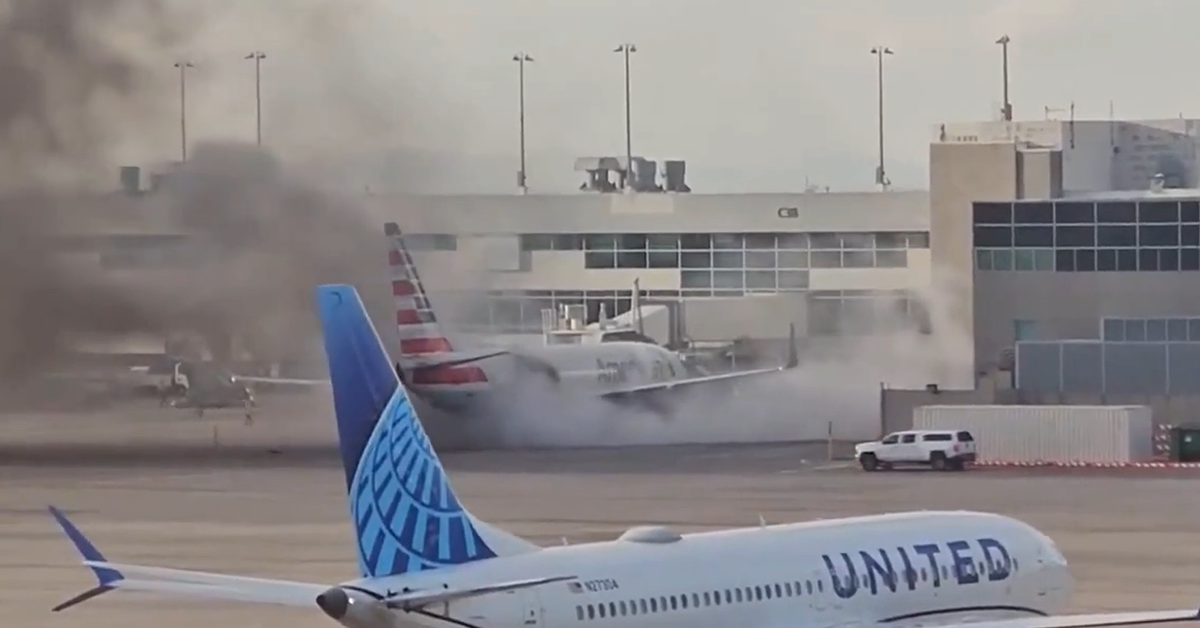American Airlines Flight 1006: Engine Fire Incident at Denver International Airport
On the evening of Thursday, March 13, 2025, a routine flight turned into a harrowing ordeal for 178 passengers and crew aboard American Airlines Flight 1006. The Boeing 737-800, en route from Colorado Springs, Colorado, to Dallas-Fort Worth, Texas, was forced to divert to Denver International Airport after the crew reported engine vibrations mid-flight. What began as a precautionary measure escalated into a dramatic emergency when, after landing safely, one of the plane’s engines caught fire while taxiing to the gate. The incident, now under investigation by the Federal Aviation Administration (FAA), has raised questions about aviation safety and the response to such crises, even as all passengers were evacuated without serious injury.
🚨 #BREAKING: An American Airlines plane is ON FIRE at Denver International Airport No word on the cause, injuries, or how many souls are on board. Rescuers are responding.
— 15News (@15News) March 14, 2025
pic.twitter.com/6keCP4qNmO
The Incident Unfolds
Flight 1006 departed Colorado Springs Airport at approximately 4:37 p.m. local time, carrying 172 passengers and six crew members. Roughly 20 minutes into the journey, the flight crew detected unusual engine vibrations—a concerning sign that prompted an immediate decision to divert to Denver, the nearest major airport equipped to handle such an emergency. The plane remained airborne for about an hour before touching down safely at Denver International Airport at around 5:15 p.m. Passengers and crew likely breathed a sigh of relief as the aircraft completed its landing without incident, but that relief was short-lived.
As the Boeing 737-800 taxied toward its assigned gate, C38, an engine fire erupted. Smoke billowed from the aircraft, and the situation quickly escalated. Videos circulating on social media captured the chaotic scene: thick gray smoke poured from the engine, and passengers could be seen evacuating onto the plane’s wing and down emergency slides. Emergency crews rushed to the tarmac, hosing down the flaming engine as airport personnel assisted the evacuees. The swift response ensured the fire was extinguished, but not before the incident left an indelible mark on those involved.
American Airlines flight 4012 caught fire after an engine failed…. Plane was diverted to Denver. pic.twitter.com/XxZUBy97Fk
— 15News (@15News) March 14, 2025
Evacuation and Safety Measures
The evacuation of Flight 1006 was a testament to both the preparedness of the crew and the inherent challenges of managing an emergency on the ground. With the aircraft already at the gate area, passengers were able to exit using the emergency slides—a standard procedure for rapid deplaning in such situations. Some reports and footage also showed individuals standing on the plane’s wing, possibly awaiting portable stairs brought by emergency responders to facilitate a safer descent. Despite the intensity of the moment, American Airlines and the FAA reported only a few minor injuries, a remarkable outcome given the potential for chaos with 178 people on board.
American Airlines issued a statement praising the professionalism of its team: “After landing safely and taxiing to the gate at Denver International Airport, American Airlines Flight 1006 experienced an engine-related issue. The 172 customers and six crew members deplaned and are being relocated to the terminal. We thank our crew members, DEN team, and first responders for their quick and decisive action with the safety of everyone on board and on the ground as the priority.” The airline’s acknowledgment of the collaborative effort underscores the critical role of training and coordination in averting disaster.
Key Details of the Incident
| Aspect | Details |
|---|---|
| Flight Number | American Airlines Flight 1006 |
| Aircraft Type | Boeing 737-800 |
| Departure | Colorado Springs Airport, 4:37 p.m. local time |
| Destination | Dallas-Fort Worth, Texas |
| Diversion Location | Denver International Airport |
| Passengers and Crew | 172 passengers, 6 crew members |
| Incident Time | Engine fire while taxiing to gate C38 at 5:15 p.m. |
| Injuries Reported | Minor injuries only |
| Investigation | FAA-led investigation into engine vibrations and fire |
The FAA Investigation
The FAA has launched a comprehensive investigation to determine the cause of both the initial engine vibrations and the subsequent fire. In a preliminary statement, the agency noted: “American Airlines Flight 1006 diverted to and landed safely at Denver International Airport around 5:15 p.m. local time on Thursday, March 13, after the crew reported engine vibrations. After landing and while taxiing to the gate, an engine caught fire, and passengers evacuated the aircraft using the slides.” The investigation will likely focus on several key questions: What triggered the vibrations mid-flight? Why did the fire ignite after landing? And could this incident have been prevented?
Engine fires, while rare, are a serious concern in aviation. They can stem from a variety of issues—mechanical failure, fuel leaks, or even damage sustained during flight. The fact that the fire occurred while the plane was taxiing suggests a possible delay between the initial problem and its manifestation as a visible blaze. Experts may examine whether the engine’s condition deteriorated during the landing process or if a secondary factor, such as a fuel line rupture, contributed to the ignition. The Boeing 737-800, a workhorse of the aviation industry, has a strong safety record, but this incident will undoubtedly prompt scrutiny of its maintenance history and operational protocols.
Passenger Experience and Public Reaction
For the passengers aboard Flight 1006, the experience was nothing short of terrifying. Imagine the scene: a smooth landing followed by the sudden sight of smoke and flames, the blare of alarms, and the urgent directive to evacuate. One passenger, Steve Schilsky, took to X to share a photo of the evacuation, writing, “Glad everyone is safe after what looked like jet fuel caught fire at Denver International…” His image depicted people on the tarmac as emergency crews worked nearby, a snapshot of relief amid the chaos.
Public reaction, amplified by social media, has ranged from concern to outrage. Posts on X highlighted the drama of the evacuation, with some users questioning the frequency of aviation incidents in recent years. “They really need to chill with these planes for a minute,” one user remarked, reflecting a sentiment of unease. Others praised the crew’s handling of the situation, noting that the lack of serious injuries was a small miracle given the circumstances. The viral nature of the videos—showing passengers on the wing and smoke pouring from the engine—only fueled the conversation, drawing attention to the fragility of air travel despite its overall safety.
Broader Implications
The Denver incident arrives at a time when aviation safety is under heightened scrutiny. While air travel remains one of the safest modes of transportation, high-profile events like this one inevitably spark debate about maintenance standards, regulatory oversight, and the aging fleet of commercial aircraft. The Boeing 737-800, introduced in the late 1990s, is a reliable model, but its longevity means many units in service today have logged thousands of flight hours. Routine maintenance is critical, and the FAA’s findings could lead to new recommendations for operators like American Airlines.
For Denver International Airport, the incident caused temporary disruptions but demonstrated the facility’s capacity to manage emergencies. As one of the busiest airports in the United States, DEN’s response—coordinating firefighting efforts, passenger relocation, and subsequent flight adjustments—will likely serve as a case study in crisis management. Airport officials have not yet detailed the full scope of operational impacts, but travelers can expect heightened vigilance in the days ahead.
Looking Forward
As of March 14, 2025, the investigation into Flight 1006 is just beginning. The FAA, possibly in collaboration with the National Transportation Safety Board (NTSB) if the incident warrants further review, will piece together the sequence of events. Passengers, meanwhile, have been rebooked or relocated, their ordeal a stark reminder of the unpredictability of travel. American Airlines faces the dual task of cooperating with authorities and reassuring the public, a challenge it has met with an emphasis on safety and gratitude for its team’s response.
For now, the skies remain open, but the flames at Denver International Airport have left a lingering question: What lessons will this incident impart? Only time—and a thorough investigation—will tell.
Q&A Section
Q1: What caused the engine fire on American Airlines Flight 1006?
A1: The exact cause is still under investigation by the FAA. Preliminary reports suggest engine vibrations mid-flight may have led to mechanical stress, potentially causing a fuel leak or other issues that ignited the fire after landing.
Q2: Were there any serious injuries reported?
A2: No, only minor injuries were reported. The swift evacuation and response by the crew and emergency teams ensured everyone’s safety.
Q3: How common are engine fires in commercial aviation?
A3: Engine fires are rare but serious events. Modern aircraft are designed with multiple safety systems to prevent and contain such incidents.
Q4: What happens to the passengers after such an incident?
A4: Passengers are typically rebooked on alternative flights, provided with accommodations if necessary, and offered support by the airline.
Q5: Will this incident affect future flights or aircraft operations?
A5: While the investigation is ongoing, airlines and regulators may review maintenance protocols and safety measures to prevent similar incidents in the future.


